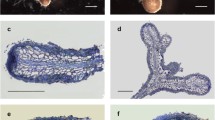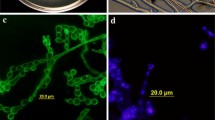Abstract
In most mycorrhizal symbioses, phylogenetically distinct fungi colonize simultaneously the roots of individual host plants. A matter of debate is whether plants can distinguish among these fungal partners and differentiate their cellular responses. We have addressed this question in the orchid mycorrhizal symbiosis, where individual roots of the Mediterranean species Limodorum abortivum can be colonized by a dominant unculturable fungal symbiont belonging to the genus Russula and by more sporadic mycelia in the genus Ceratobasidium (form-genus Rhizoctonia). The phylogenetic position of the Ceratobasidium symbionts was further investigated in this work. Both Russula and Ceratobasidium symbionts form intracellular coils in the cortical roots of L. abortivum, but hyphae are very different in size and morphology, making the two fungi easily distinguishable. We have used John Innes Monoclonal 5, a widely used monoclonal antibody against pectin, to investigate the composition of the symbiotic plant interface around the intracellular coils formed by the two fungal partners. Immunolabelling experiments showed that pectin is exclusively found in the interface formed around the Ceratobasidium, and not around the Russula symbiont. These data indicate that the plant responses towards distinct mycorrhizal fungal partners can vary at a cellular level.



Similar content being viewed by others
References
Alguacil MM, Roldán A, Torres MP (2009) Complexity of semiarid gypsophilous shrub communities mediates the AMF biodiversity at the plant species level. Microb Ecol 57:718–727
Balestrini R, Hahn MG, Faccio A et al (1996) Differential localization of carbohydrate epitopes in plant cell walls in the presence and absence of arbuscular mycorrhizal fungi. Plant Physiol 111:203–213
Bidartondo MI, Read DJ (2008) Fungal specificity bottlenecks during orchid germination and development. Mol Ecol 17:3707–3716
Bonfante P, Perotto S (1995) Tansley Review N. 82. Strategies of arbuscular mycorrhizal fungi when infecting host plants. New Phytol 130:3–21
Bougoure DS, Cairney JWG (2005) Assemblages of ericoid mycorrhizal and other root-associated fungi from Epacris pulchella (Ericaceae) as determined by culturing and direct DNA extraction from roots. Environ Microbiol 7:819–827
D’Ovidio R, Mattei B, Roberti S et al (2004) Polygalacturonases, polygalacturonase-inhibiting proteins and pectic oligomers in plant–pathogen interactions. Biochim Biophys Acta 1696:237–244
Day DA, Kaiser BN, Thomson R et al (2001) Nutrient transport across symbiotic membranes from legume nodules. Aust J Plant Physiol 28:667–674
Dearnaley JDW (2007) Further advances in orchid mycorrhizal research. Mycorrhiza 17:475–486
Gebauer G, Meyer M (2003) N-15 and C-13 natural abundance of autotrophic and myco-heterotrophic orchids provides insight into nitrogen and carbon gain from fungal association. New Phytol 160:209–223
Gianinazzi-Pearson V, Gianinazzi S, Guillemin JP, Trouvelot A, Duc G (1991) Genetic and cellular analysis of resistance to vesicular arbuscular (VA) mycorrhizal fungi in pea mutants. In: Hennecke H, Verma DPS (eds) Advances in molecular genetics of plant–microbe interactions. Kluwer Academic, Dordrecht, pp 336–342
Girlanda M, Selosse MA, Cafasso D et al (2006) Inefficient photosynthesis in the Mediterranean orchid Limodorum abortivum is mirrored by specific association to ectomycorrhizal Russulaceae. Mol Ecol 15:491–504
Hadley G (1970) Non-specificity of symbiotic infection in orchid mycorrhiza. New Phytol 69:1015–1023
Harrison MJ (2005) Signaling in the arbuscular mycorrhizal symbiosis. Annu Rev Microbiol 59:19–42
Huynh TT, Thomson R, Mclean CB et al (2009) Functional and genetic diversity of mycorrhizal fungi from single plants of Caladenia formosa (Orchidaceae). Ann Bot London 104:757–765
Huelsenbeck JP, Ronquist F (2001) MrBayes: Bayesian inference of phylogenetic trees. Bioinformatics 17:754–755
Huelsenbeck JP, Larget B, Miller RE et al (2002) Potential applications and pitfalls of Bayesian inference of phylogeny. Syst Biol 51:673–688
Jansa J, Smith FA, Smith SA (2008) Are there benefits of simultaneous root colonization by different arbuscular mycorrhizal fungi? New Phytol 177:779–789
Knox JP, Linstead PJ, King J et al (1990) Pectin esterification is spatially regulated both within cell walls and between developing tissues of root apices. Planta 181:512–521
Larkin MA, Blackshields G, Brown NP et al (2007) Clustal W and Clustal X version 2.0. Bioinformatics 23:2947–2948
Leake JR (1994) Tansley Review N. 69. The biology of mycoheterotrophic (‘saprophytic’) plants. New Phytol 127:171–216
Martin F, Aerts A, Ahren D et al (2008) The genome of Laccaria bicolor provides insights into mycorrhizal symbiosis. Nature 452:88–93
McKendrick SL, Leake JR, Read DJ (2000) Symbiotic germination and development of myco-heterotrophic plants in nature: transfer of carbon from ectomycorrhizal Salix repens and Betula pendula to the orchid Corallorhiza trifida through shared hyphal connections. New Phytol 145:539–548
Nagendran S, Hallen-Adams HE, Paper JM et al (2009) Reduced genomic potential for secreted plant cell-wall-degrading enzymes in the ectomycorrhizal fungus Amanita bisporigera, based on the secretome of Trichoderma reesei. Fungal Genet Biol 46:427–435
Oldroyd GED, Harrison MJ, Paszkowski U (2009) Reprogramming plant cells for endosymbiosis. Science 324:753–754
Opik M, Metsis M, Daniell TJ et al (2009) Large-scale parallel 454 sequencing reveals host ecological group specificity of arbuscular mycorrhizal fungi in a boreonemoral forest. New Phytol 184:424–437
Parniske M (2004) Molecular genetics of the arbuscular mycorrhizal symbiosis. Curr Opin Plant Biol 7:414–421
Perotto S, Brewin NJ, Bonfante P (1994) Colonization of pea roots by the mycorrhizal fungus Glomus versiforme and by Rhizobium bacteria: immunological comparison using monoclonal antibodies as probes for plant-cell surface components. Mol Plant Microbe Int 7:91–98
Perotto S, Peretto R, Faccio A et al (1995) Ericoid mycorrhizal fungi: cellular and molecular bases if their interactions with the host plant. Can J Bot 73:S557–S568
Perotto S, Actis Perino E, Perugini J et al (1996) Molecular diversity of fungi from ericoid mycorrhizal roots. Mol Ecol 5:123–131
Peterson RL, Massicotte HB (2004) Exploring structural definitions of mycorrhizas, with emphasis on nutrient-exchange interfaces. Can J Bot 82:1074–1088
Peterson RL, Bonfante P, Faccio A et al (1996) The interface between fungal hyphae and orchid protocorm cells. Can J Bot 74:1861–1870
Posada D (2008) jModeltest: phylogenetic model averaging. Mol Biol Evol 25:1253–1256
Ridley BL, O’Neill MA, Mohnen D (2001) Pectins: structure, biosynthesis, and oligogalacturonide-related signaling. Phytochemistry 57:929–967
Rasmussen HN (2002) Recent developments in the study of orchid mycorrhiza. Plant Soil 244:149–163
Roy M, Watthana S, Stier A et al (2009) Two mycoheterotrophic orchids from Thailand tropical dipterocarpacean forests associate with a broad diversity of ectomycorrhizal fungi. BMC Biol 7:51
Sharples JM, Chambers SM, Meharg AA et al (2000) Genetic diversity of root-associated fungal endophytes from Calluna vulgaris at contrasting field sites. New Phytol 148:153–162
Stark C, Babik W, Durka W (2009) Fungi from the roots of the common terrestrial orchid Gymnadenia conopsea. Mycol Res 113:952–959
Suarez JP, Weiss M, Abele A et al (2006) Diverse tulasnelloid fungi form mycorrhizas with epiphytic orchids in an Andean cloud forest. Mycol Res 110:1257–1270
Sweetingham MW, Cruickshank RH, Wong DH (1986) Pectic zymograms and taxonomy and pathogenicity of Ceratobasidiaceae. Trans Brit Mycol Soc 86:305–311
Tamura K, Dudley J, Nei M et al (2007) MEGA4: molecular evolutionary genetics analysis (MEGA) software version 4.0. Mol Biol Evol 24:1596–1599
Taylor DL, Bruns TD, Leake JR, Read DJ (2002) Mycorrhizal specificity and function in myco-heterotrophic plants. In: Mycorrhizal ecology, Van der Heijden MGA, Sanders I (eds) Ecological Studies 157:375–413
Taylor DL, Bruns TD, Szaro TM, Hodges SA (2003) Divergence in mycorrhizal specialization within Hexalectris spicata, a nonphotosynthetic desert orchid. Am J Bot 90:1168–1179
van der Heijden MAG, Klironomos JN, Ursic M et al (1998) Mycorrhizal fungal diversity determines plant biodiversity, ecosystem variability and productivity. Nature 396:69–72
Yukawa T, Ogura-Tsujita Y, Shefferson RP et al (2009) Mycorrhizal diversity in Apostasia (Orchidaceae) indicates the origin and evolution of orchid mycorrhiza. Am J Bot 96:1997–2009
Acknowledgments
We thank Mara Novero for her technical help. MR was supported by the Fondazione CRT with a Progetto Lagrange fellowship. Research was funded by MIUR (PRIN 2007 Project) and by local funding by the University of Torino.
Author information
Authors and Affiliations
Corresponding author
Rights and permissions
About this article
Cite this article
Paduano, C., Rodda, M., Ercole, E. et al. Pectin localization in the Mediterranean orchid Limodorum abortivum reveals modulation of the plant interface in response to different mycorrhizal fungi. Mycorrhiza 21, 97–104 (2011). https://doi.org/10.1007/s00572-010-0315-5
Received:
Accepted:
Published:
Issue Date:
DOI: https://doi.org/10.1007/s00572-010-0315-5




